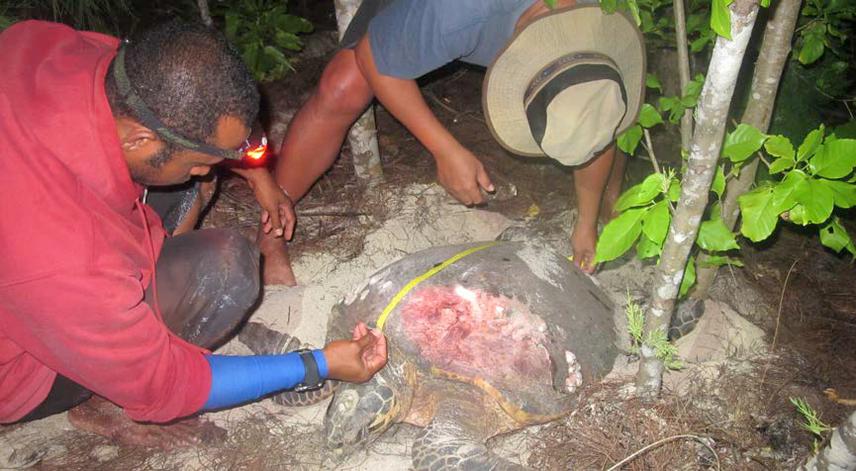Ricardo F. Tapilatu
Other projects
8 Nov 2012
Monitoring and Conservation of the Sea Turtle Nesting Population at Yembekaki Beach on the Waigeo Island of West Papua – Indonesia
The main aim is to initiate monitoring and conservation efforts in critical habitats for sea turtles in the four districts in Papua Barat Province, and to assess existing and potential threats to nesting habitat and population.

17595-2 Measuring curved carapace length of a green sea turtle in Venu Island, Kaimana.
The Pacific leatherback turtle population has declined significantly and the western Pacific population represents the best remaining prospect for avoiding extinction. Nesting population monitoring is ongoing for leatherbacks and other turtles in index nesting beaches at the north coast of the Bird’s Head Peninsula. When nesting at these beaches, these turtles and their nests are largely protected from harvest. If they, however, nest elsewhere, they would be at risk of being harvested because they have broad homing and nest all over the Bird’s Head peninsula. Data on leatherbacks and other marine turtles on nesting activity on non-index beaches are scarce. Anecdotal observations identified four smaller historic sea turtle rookeries at Bird’s Head: Yapen, Wondama, Manokwari, and Kaimana. These areas host nesting olive-ridley and green turtles, which are endangered, and critically endangered leatherback and hawksbill turtles. Seasonal sightings of leatherbacks in surrounding waters suggest these areas might serve as important internesting areas. Because of their proximities to populated areas, turtles and their eggs at the four rookeries are harvested and are typically sold in markets. Getting information on nesting population status at non-index beaches, and protecting turtles nesting there are important to support ongoing marine turtle conservation and ultimately population recovery.
Our work will fill an important gap in knowledge on marine turtle nesting activity and threats that face them at Bird’s Head. We suspect poaching is occurring because turtle meat and eggs have long been a source of protein for local people. We also suspect that feral dogs and pigs are depredating turtle nests as we have seen at index beaches. Quantifying the number of nests, the number of females nesting, the threats to turtles and their nests, and tracking them over time is critical for directing conservation efforts. This information can be brought to the attention of local government, and they can respond with appropriate management actions, as exemplified by sea turtles conservation initiatives established on Yembekaki, north Waigeo Island of Raja Ampat. More importantly, our work will be a beginning step towards expanding the umbrella of protection for marine turtles in the region. Community support and involvement are crucial for lasting protection of turtles nesting in these areas. With YPP, we will involve communities since the beginning and raise them as conservation cadres to conduct long-term monitoring and protecting of nesting turtles.